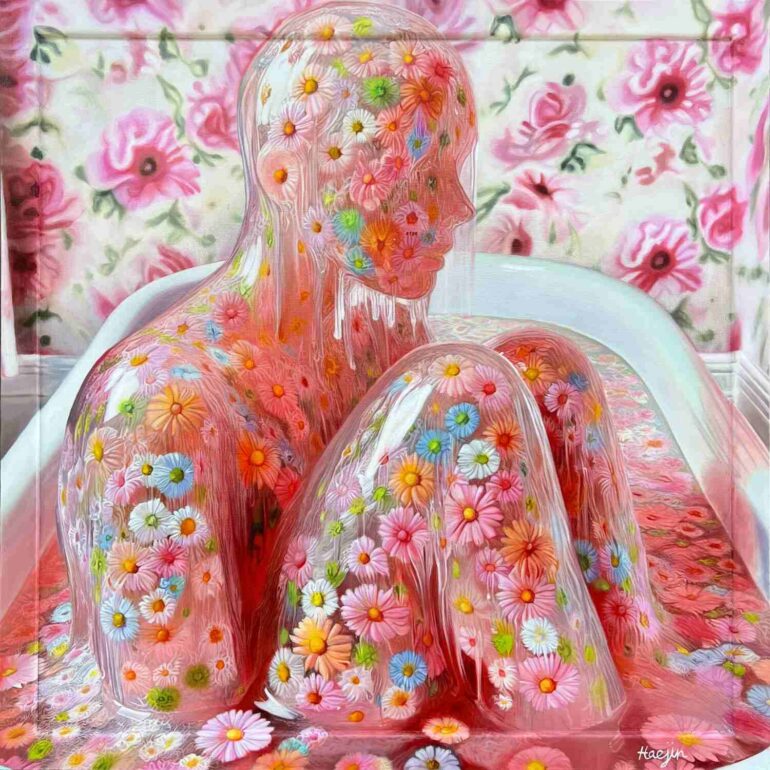Exclusive Interview With Haejin Yoo, 2nd Prize Winner of the RAYMAR Traditional Art Award, 2024 Beautiful Bizarre Art Prize by Samantha Dexter
The home is a sacred place. It’s a place where the stress and anxiety of the outer world melt away into a puddle at the doorstep, only to be retrieved on the way out like a pair of shoes. There are many facets to this sacred place. First off is the living room, the entertainment hub made of squishy sofas and piles of DVDs. Next, the kitchen which offers a range of goodies including warm, home cooked meals. Making our way upstairs, we have the bedroom, a place that offers rest to weary workers where jobs are traded-in for dreams. Finally, we have the bathroom, which to Haejin Yoo, is the real sanctuary of the home.
The bathroom is the place where not even your clothes are invited. It offers the most raw version of yourself. A place to simply exist. As you become one with the water, every mask, every facade, every version of you that has existed, simply melts away and you breathe a sigh of relief.
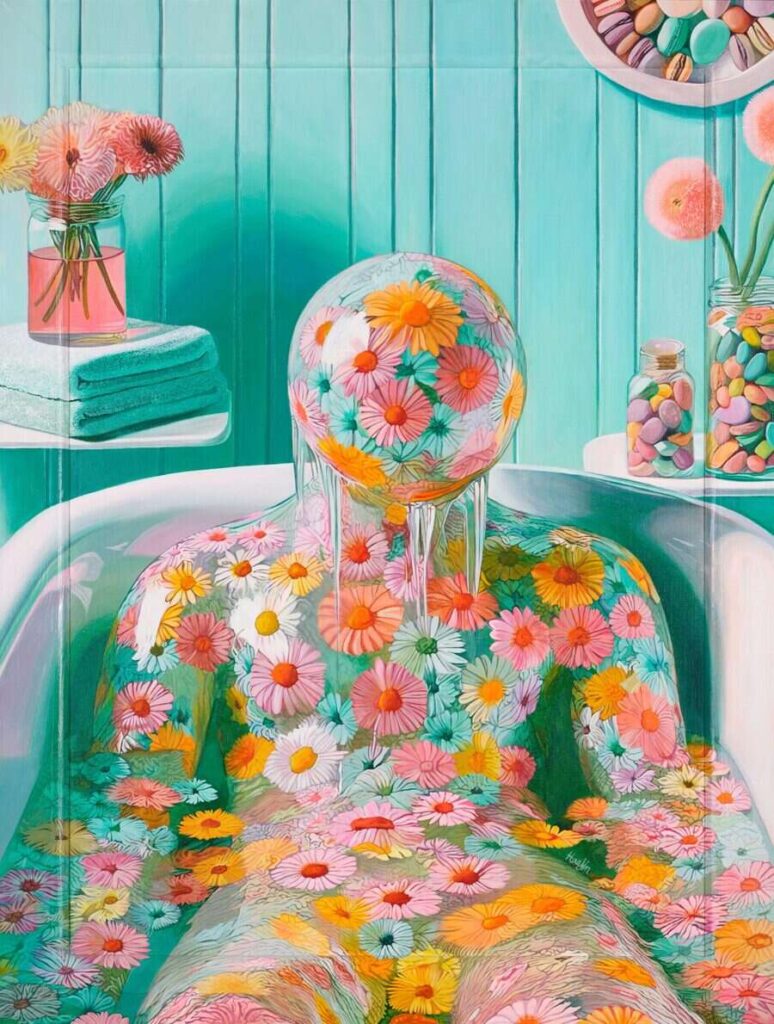
Acrylic on linen and wood
2nd Prize Winner
RAYMAR Traditional Prize Beautiful Bizarre Prize 2024
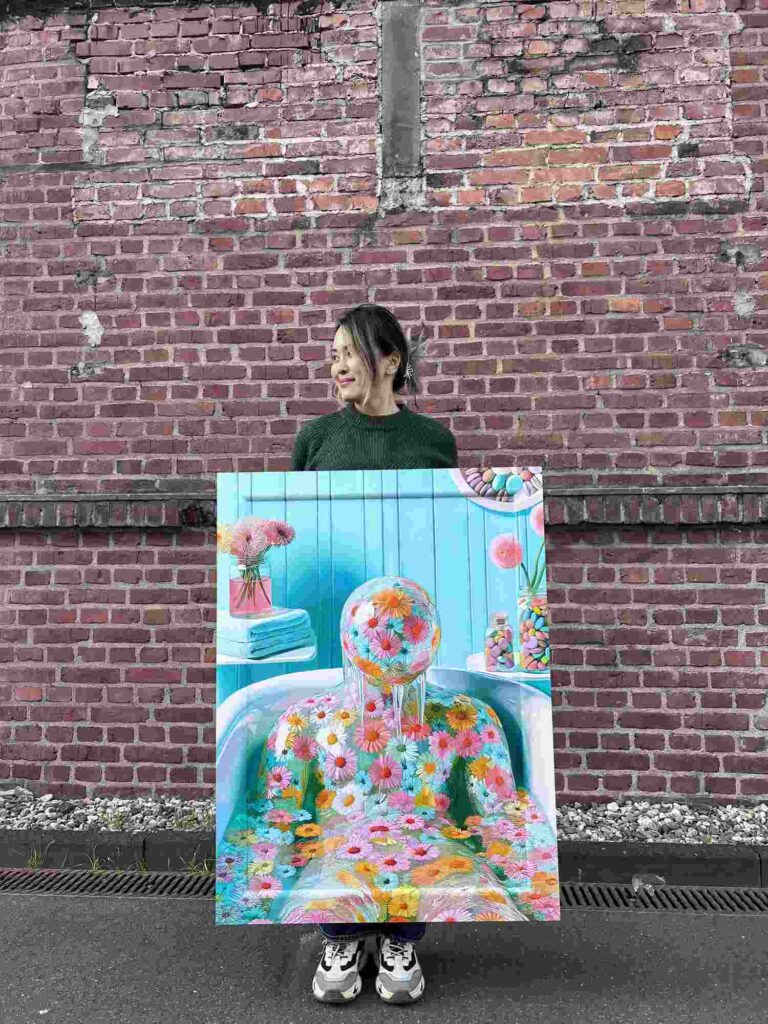
Haejin Yoo is a South Korean artist whose work explores surrealist themes alongside symbolism that is prevalent in our current world. Born in Seoul, and raised in Australia, Haejin, is a self-taught artist who integrates a variety of mediums into her work including acrylic, spray paint, oils, textiles and carpentry into her work. Through her chosen mediums she explores her unique perspective on themes of identity, introspection and emotion all while pushing the boundaries of her artistic capabilities.
While art has been a life long passion for Haejin, she didn’t pursue painting until her late twenties in which she would trade her work in the sciences for a paint brush and canvas. Since switching careers, Haejin has exhibited her work extensively across the globe and is currently based in Sydney, Australia.
In 2024, Haejin entered into the Beautiful Bizarre Art Prize, winning the 2nd Prize RAYMAR Traditional Art Award with her painting ‘Woman in a Bath VI’. This piece was inspired by Haejin’s husband, exploring masculinity and empowerment and is part of her ongoing ‘Woman in a Bath’ series. The series currently spans over 10 artworks and only continues to grow as Haejin explores the fluid nature of identity and persona throughout her life.
One unexpected gift from the [Art] Prize has been the confidence to take more risks in my work. The recognition has helped me trust my instincts and push my creative boundaries further.
Interview with Haejin Yoo
First off, I want to congratulate you on your success in the Art Prize! How did you feel upon learning that you’d won?
Thank you so much! Honestly, I didn’t expect to win at all. I would have been overjoyed just to make it as a finalist, given the incredible talent of the artists who submitted their work. Initially, I misread the notification email for the Emerging Artist Award and assumed it applied to the Fine Art Award. When I didn’t see my name on the finalist list, I felt a deep sense of disappointment that lingered for a couple of weeks. Then, one morning, I woke up to an email announcing that I had won second prize in the Fine Art Award category. I was in complete shock! I immediately woke my husband up — quite violently, I might add — to share the news, and we just screamed with excitement.
This recognition felt monumental to me. I’ve been navigating what often seemed like a hopeless journey as an artist for almost 14 years, with nearly 8 of those years spent working full-time. While I’ve been fortunate to win awards in the past, nothing has come close to the significance and impact of this one. It truly felt like a turning point in my career.
Why did you decide to enter the Beautiful Bizarre Art Prize?
I wanted to take a chance with my new series, ‘Women in the Bath’. Beautiful Bizarre has always been a platform I deeply admire, both for the incredible artists it represents and for its dedication to celebrating unique, thought-provoking art. While I didn’t know what the outcome would be, I felt inspired to put my work alongside such amazing talent and to be part of this vibrant artistic community.
‘Women in the Bath VI’ is part of your ongoing ‘Woman in the Bath’ series, can you tell us a bit about how the initial concept for this series started and what made you want to continue exploring it further?
For a long time, I struggled to find my artistic voice. As someone on the autism spectrum, I’ve often masked my traits to fit into what I believed was “normal.” This extended to my art, where I painted what I thought people would like rather than what I truly connected with. The result was a sense of disconnect and frustration, even though I knew art was my life’s path.
The turning point came after a difficult art fair in LA. I had poured myself into creating a series that I thought would appeal to others — spending 400 hours on each piece and even trying to reinvent myself outwardly to fit in. But I left the fair feeling profoundly sad, not because of the lack of success but because I realised I wasn’t being true to myself. That moment of clarity gave me the courage to embrace my quirks and passions, including my love for things that are both weird and beautiful.
The ‘Woman in the Bath’ series was born from this realization and deeply personal experiences. After the birth of my daughter, I struggled with postpartum depression while living as an expat in Germany, far from family and friends. My daily baths with my infant daughter became a time of reflection — a space where the masks I wore as a mother, neighbour, and friend melted away. In the bath, I felt vulnerable, pondering my worth and existence.
The melting flowers in the series symbolize the facades we wear — beautiful yet fleeting, like gerberas, which I’ve always associated with superficiality. The thick goo enveloping the figure represents the layers of these facades. As someone on the spectrum, masking has been a constant part of my life, and this series explores the blurred line between our authentic selves and the personas we present to the world.
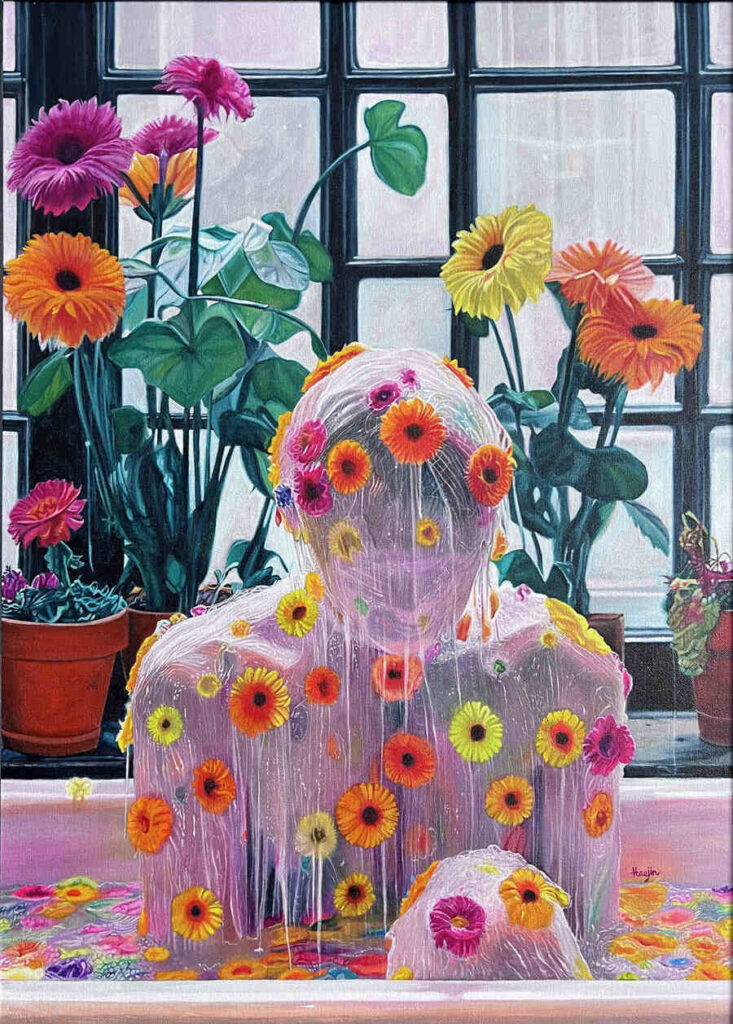
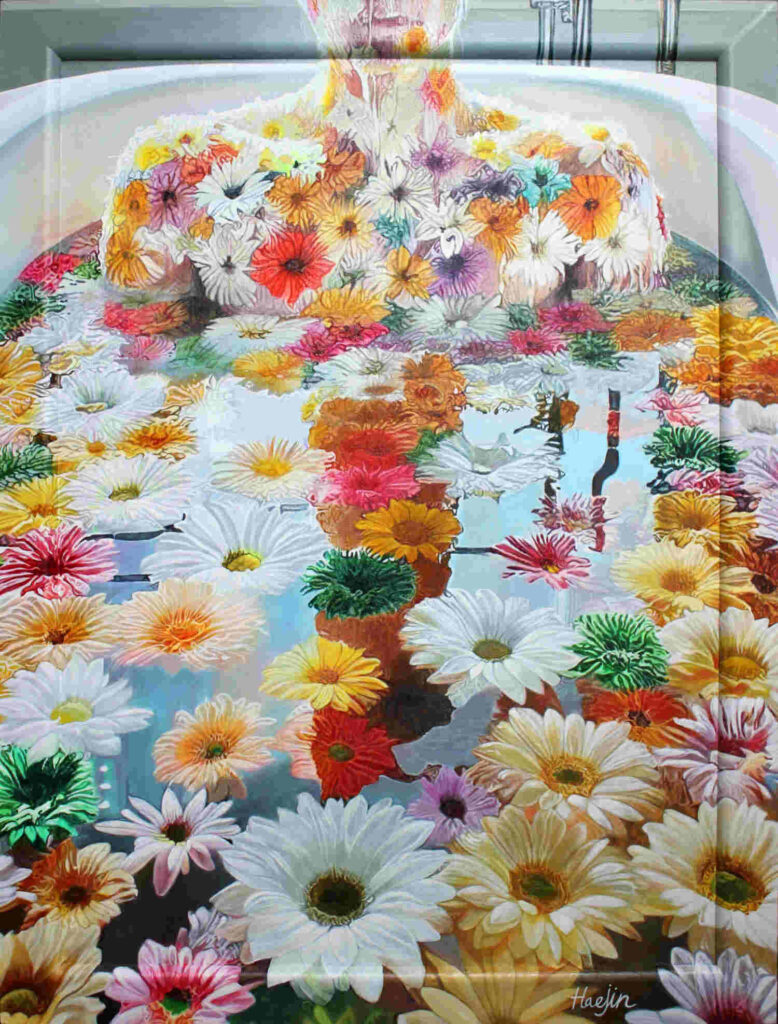
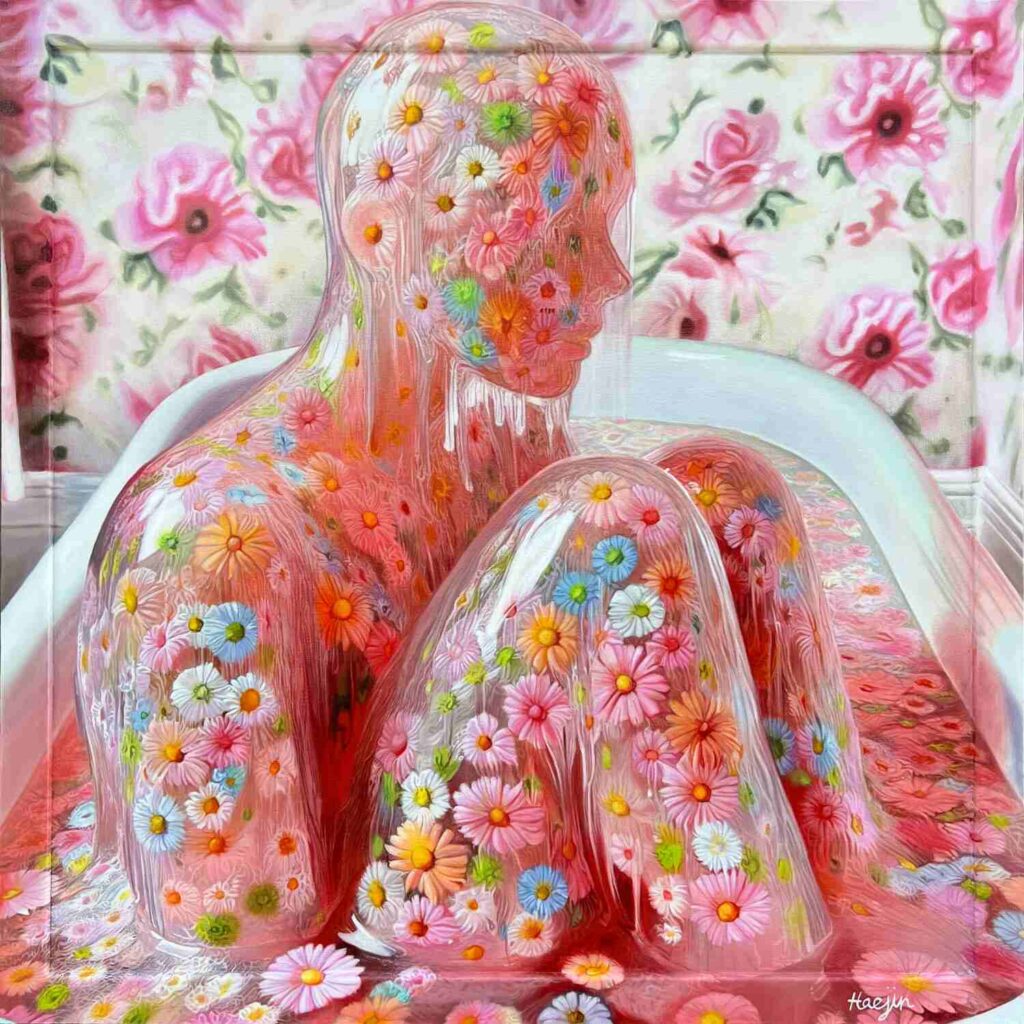
‘Women in the Bath VI’ continues your exploration of “the modern concept of persona” and how fluid we are as we are shaped by our life experiences. Humanity, in a way, is similar to water being fluid and free flowing in nature all while being able to change or stay the same depending on the circumstance. What are your thoughts on this interpretation?
I think this is a wonderful interpretation! Persona is incredibly fluid, and as I’ve mentioned, it’s often difficult to truly distinguish or label oneself. Our sense of self is ever-changing, shaped by experiences, relationships, and time. I believe in the power of change — I’ve changed so much over the decades, and I see that as a natural part of being human.
Even the flowers in my work, which symbolize facades, reflect this fluidity. They may melt away, revealing something underneath, but they can also reform, take on new shapes, or even become a part of us. This fluidity mirrors how we adapt and grow, sometimes shedding layers of ourselves while integrating others. It’s this constant evolution that makes humanity so beautifully complex.
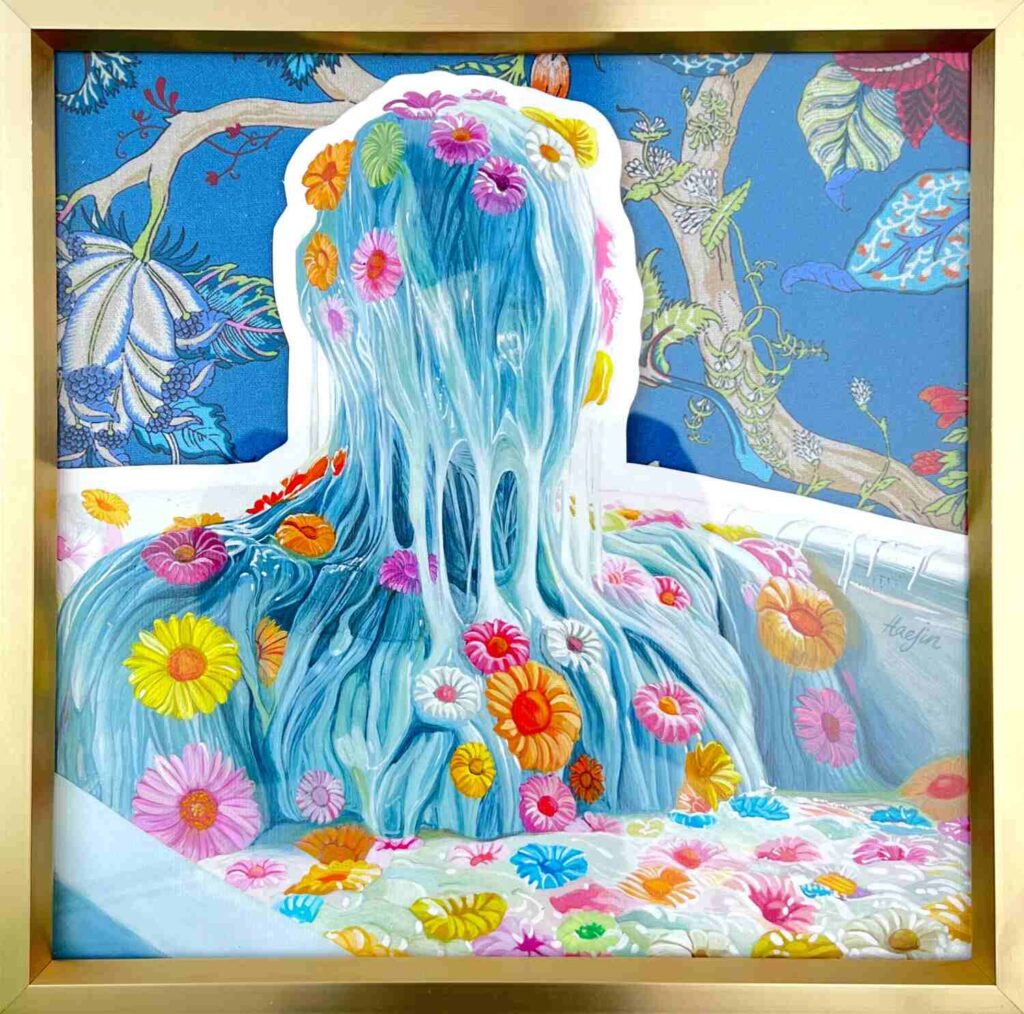
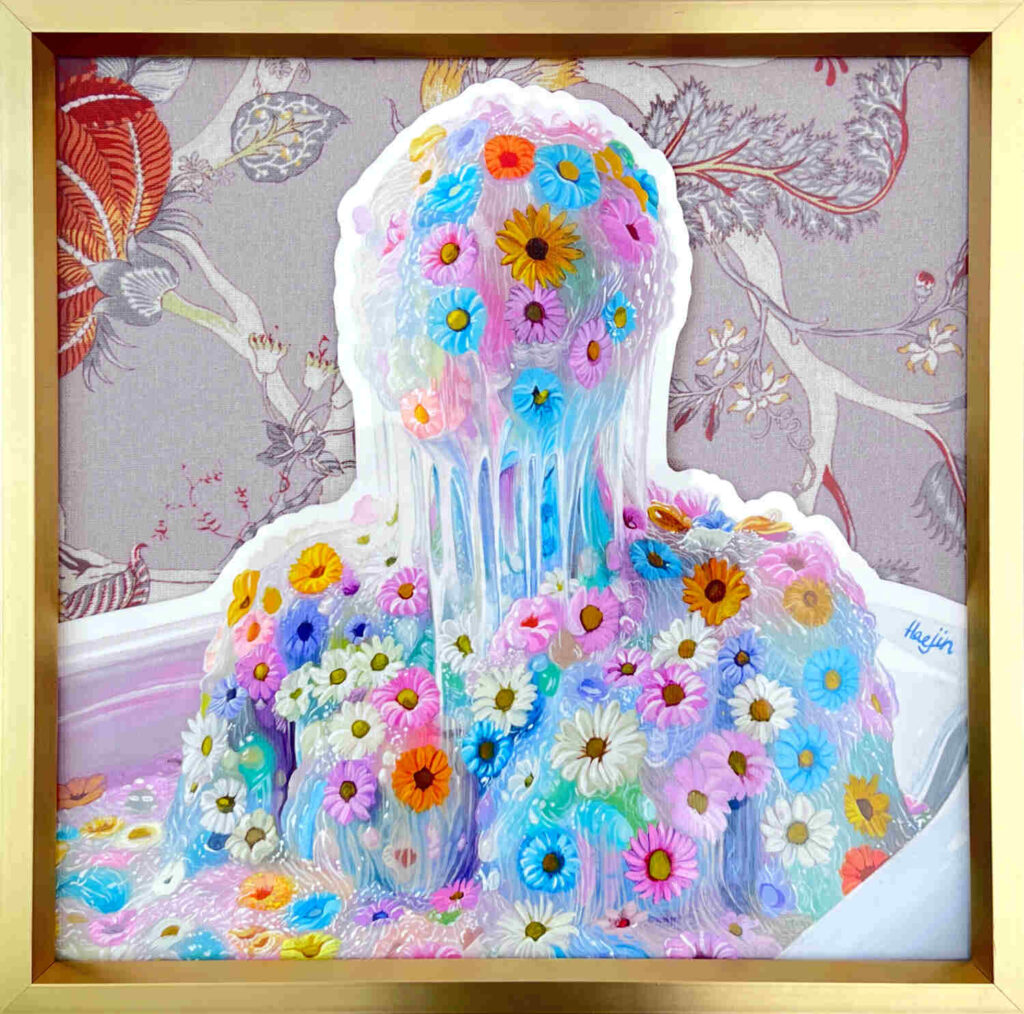
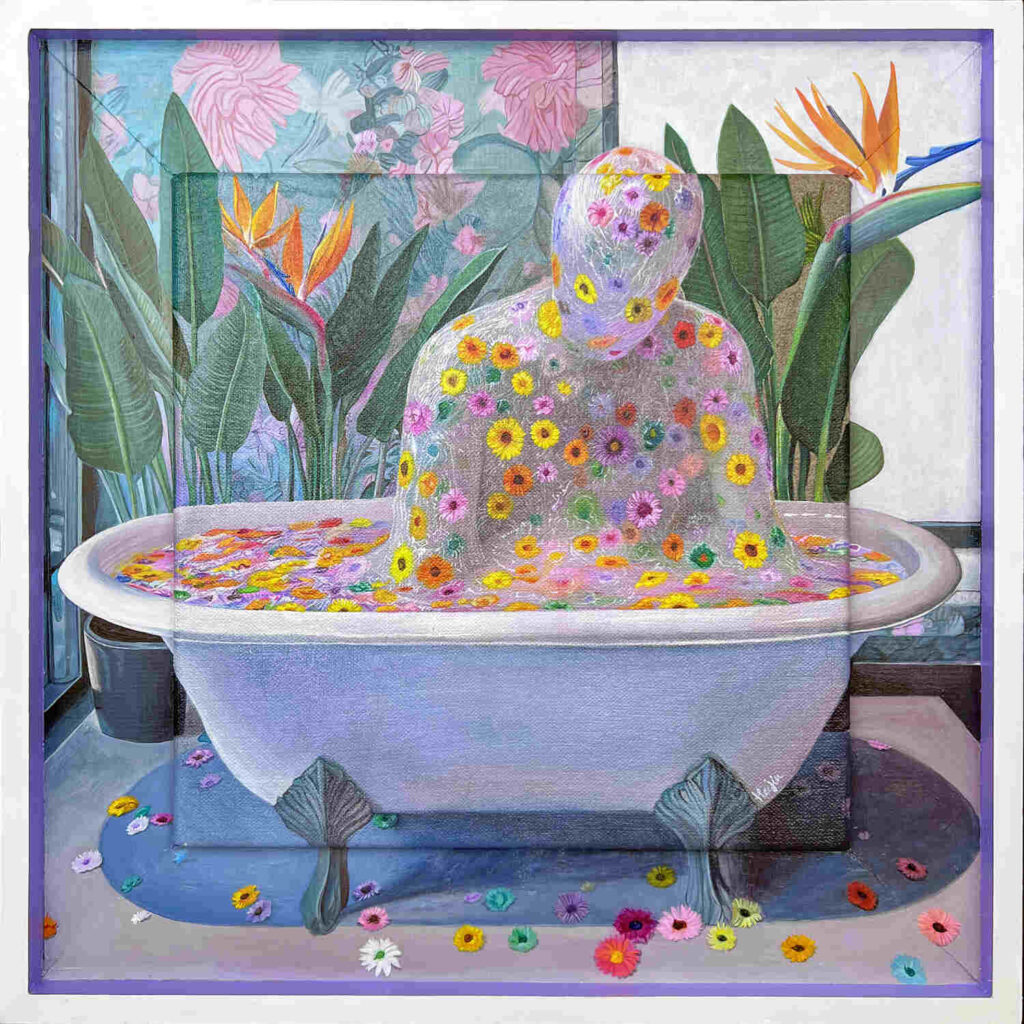
The paintings in this series also explore what you describe as the sanctuary of the bathroom. Why choose the bathroom as opposed to the intimacy of a bedroom or the comfort of a living room?
The bathroom, to me, is the place where you can be your rawest, most exposed self. It’s a space of complete solitude — a place where you can think, feel, or do things you wouldn’t in front of others. Unlike the bedroom or living room, where we can still be surrounded by people or distractions, the bathroom offers a sanctuary of true privacy. It’s where masks come off, both literally and metaphorically, allowing for moments of vulnerability, reflection, and authenticity.
Carpentry plays a significant role within your art practice as you build your own frames to give your pieces a more captivating effect. Can you tell us more about your interest in carpentry and how it informs the rest of your art practice?
My journey into carpentry began more out of necessity than intention. To be completely honest, it was a way to combat the challenges of being a struggling artist. I couldn’t afford pre-made canvases, so I started building my own. However, I encountered issues with the stretcher bars I ordered — sometimes they were slightly off in their measurements, resulting in skewed frames. This became especially noticeable when I was fitting my paintings into floating frames, which I was also making myself to save on costs.
To address this, I came up with the idea of creating a square frame that would go over the canvas. As I experimented, I realized that painting directly onto this additional frame created a unique sense of introspection and depth, perfectly complementing the ‘Woman in the Bath’ series. What started as a practical solution evolved into an integral part of my creative process, allowing me to expand the narrative of my work beyond the boundaries of the canvas.
What are some of the biggest challenges you have faced as a self-taught artist and how have you overcome them?
One of the biggest challenges I faced as a self-taught artist was the lack of connections and guidance. Without a formal art education or established network, I often felt like I was navigating blindly, unsure of how to progress or where to turn for advice.
It took a long time, but I started building connections through opportunities like participating in The Other Art Fair. There, I met more experienced artists who were incredibly kind and generous with their advice, offering me valuable direction. Over time, I expanded my network further by connecting with other artists on Instagram, which became another great source of inspiration and guidance.
These small but meaningful steps helped me find my footing, and they reminded me of the importance of community in the art world. It’s a journey, but each connection has made a significant difference in shaping my path.
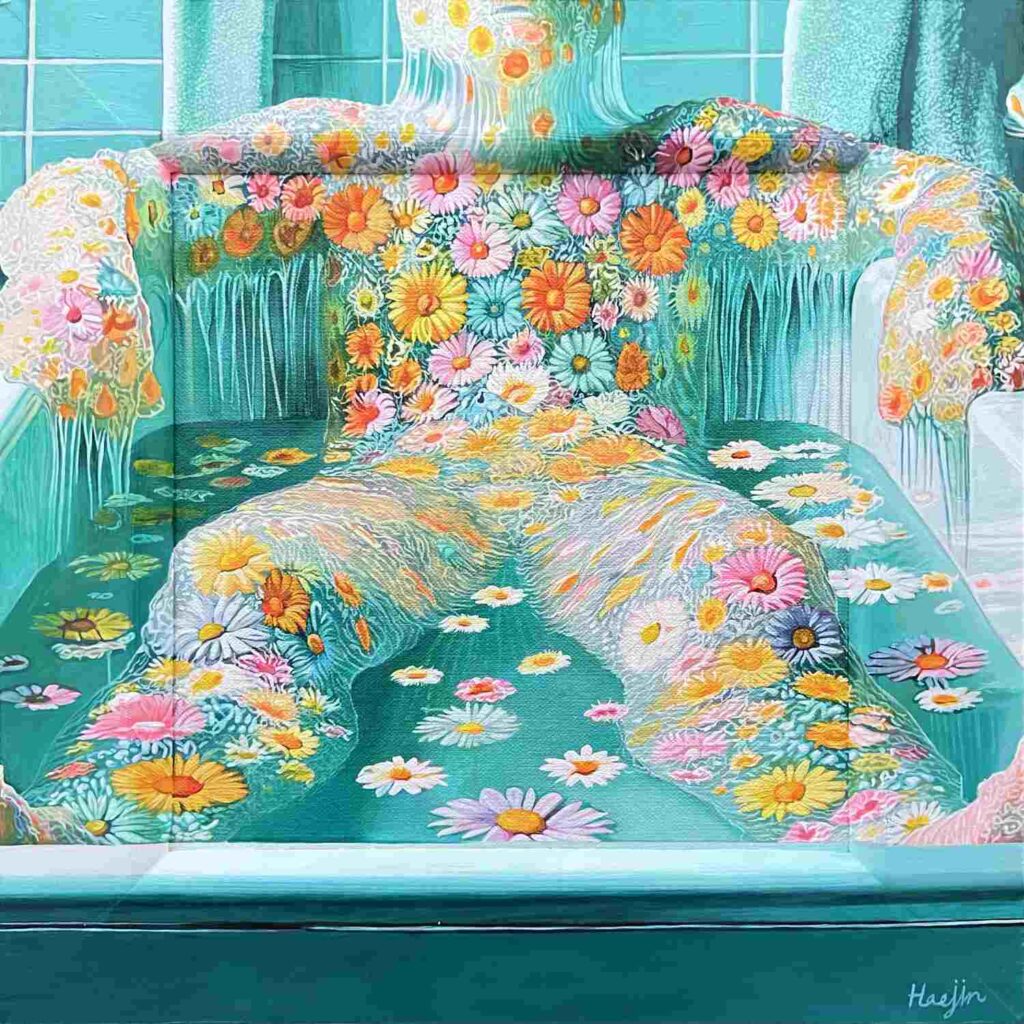
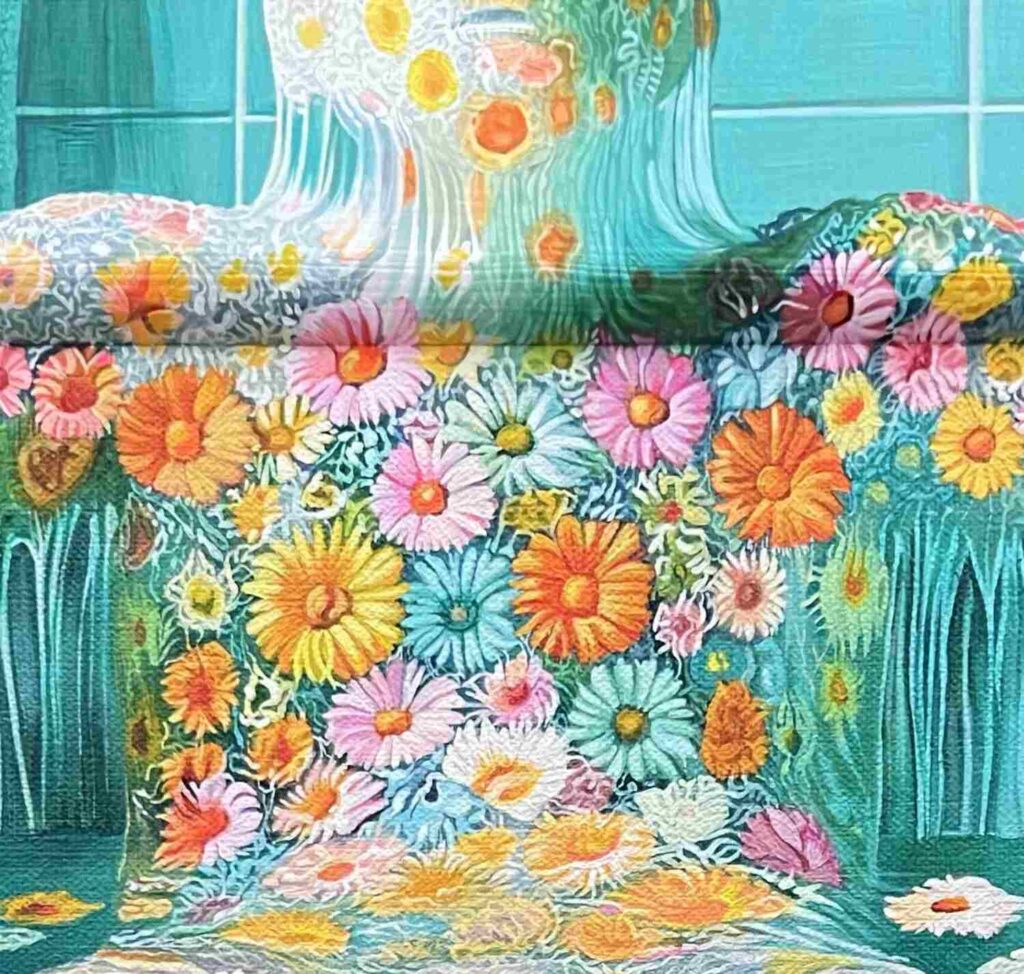
What do you feel you have gained from participating in the Beautiful Bizarre Art Prize? Would you recommend the Beautiful Bizarre Art Prize and encourage others to enter? If so, why?
Participating in the Beautiful Bizarre Art Prize has been a pivotal moment in my career, not just because of the recognition but also because of the doors it has opened. Winning 2nd Prize in the Fine Art category was a profound reminder that my work resonates with people beyond my studio walls. As an artist, it’s easy to feel isolated in your practice, questioning whether what you’re creating has meaning or value to others. This prize gave me a clear answer to that question — it was a resounding “yes.”
The exposure and support I’ve received have been invaluable. It’s not just about the title or the prize itself, but about the community and connections I’ve gained through Beautiful Bizarre. It’s rare to find a platform that celebrates such a diverse range of artistic voices, and being part of this has made me feel seen in a way I hadn’t experienced before. I’ve also had the chance to connect with other finalists and winners, and those relationships have been both inspiring and encouraging.
One unexpected gift from the prize has been the confidence to take more risks in my work. The recognition has helped me trust my instincts and push my creative boundaries further. It’s also led to new opportunities, including collaborations and exhibitions, that I wouldn’t have imagined possible a year ago.
I would absolutely recommend the Beautiful Bizarre Art Prize to other artists. It’s not just about the potential to win, but about the experience of being part of something bigger — a global celebration of creativity and innovation. Even if you don’t win, you’re putting your work in front of an audience that truly appreciates and understands art. That alone is worth it.
What has been inspiring you lately?
Lately, I’ve found myself drawn to the delicate beauty of glass figurines. There’s something mesmerising about their transparency, fragility, and how they catch and refract light. In many ways, they remind me of the clarity I’ve gained about myself since my recent autism spectrum diagnosis. Understanding this part of me has been transformative — it’s as if I’m seeing my own identity with a new level of transparency and acceptance, much like how light passes through glass, revealing its hidden depths.
This newfound clarity has sparked a desire to explore this theme further in my work. I’m fascinated by how glass can symbolise both strength and vulnerability, and I’d love to study this material more deeply this year. At the same time, I’m feeling a pull back toward figurative art, which has always been a grounding element in my practice. I think combining these inspirations — glass and the human form — could lead to something really meaningful and exciting in my future pieces.
What can we hope to see from you in 2025?
The ‘Woman in the Bath’ series will definitely continue to evolve — it’s a theme that still resonates deeply with me and offers so much more to explore. My schedule for 2025 is already packed with exciting exhibitions in the US and New Zealand, so I’ll be consistently creating new work throughout the year.
This year, I’m planning to shift my focus to smaller-scale pieces, around 60cm or less. After working on larger canvases last year, I’m excited about the intimacy and detail that smaller works can bring. It’s a chance to challenge myself and refine my storytelling in a more condensed space.
Additionally, I’m looking forward to experimenting with new materials and ideas, including inspirations from glass and figurative art, as I mentioned earlier. 2025 feels like a year of refining my voice and exploring new dimensions in my art while continuing to share my journey with a broader audience.
